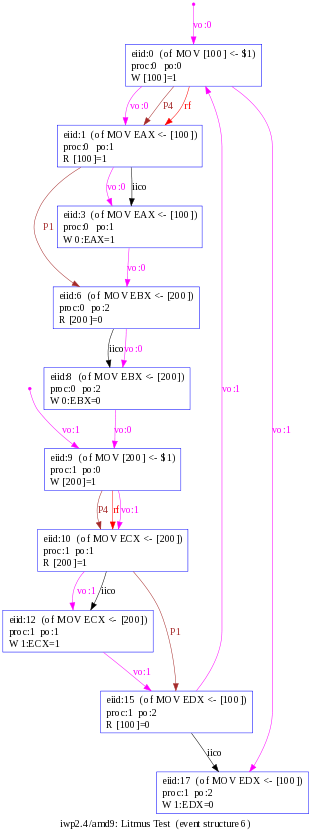The Semantics of Power and ARM Multiprocessor Programs
Multiprocessors are now dominant, but real multiprocessors do not provide the sequentially consistent memory that is assumed by most work on semantics and verification. Instead, they have subtle relaxed (or weak) memory models, usually described only in ambiguous (and sometimes flawed) prose, leading to widespread confusion.
We are working to develop mathematically rigorous and usable semantics for multiprocessor programs, focussing on three architectures: x86 (Intel 64/IA-32 and AMD64), Power, and ARM. Such models should provide a solid intuition for low-level programming, and a sound foundation for future work on verification, static analysis, and compilation of low-level concurrent code, and for the design of high-level concurrent programming languages.
This work is associated with a broader project on Relaxed-Memory Concurrency.
Power and ARM
The Power and ARM architectures have very different memory models to x86, but are broadly similar to each other. For Power, we have produced several models. Our PLDI 2011 paper gives an abstract-machine model that, to the best of our knowledge, accurately captures the architectural intent and observable processor behaviour for a wide range of subtle examples. The TACAS 2011 tool paper describes our Litmus experimental testing tool. The CAV 2010 paper gives an earlier axiomatic model that is sound with respect to current POWER processor behaviour, as far as we know, but does not match the architectural intent for some examples (as described in the PLDI 2011 paper). It is based on a general framework developed in Alglave's thesis. The DAMP 2009 paper gives a very preliminary axiomatic model, based on a naive reading of the Power and ARM vendor documentation.
- Understanding POWER Multiprocessors. Susmit Sarkar, Peter Sewell, Jade Alglave, Luc Maranget, Derek Williams. In PLDI 2011
- Litmus: Running Tests Against Hardware. Jade Alglave, Luc Maranget, Susmit Sarkar and Peter Sewell. Tool Demonstration Paper. In TACAS 2011.
- Fences in Weak Memory Models. Jade Alglave, Luc Maranget, Susmit Sarkar and Peter Sewell In CAV 2010.
- The Semantics of Power and ARM Multiprocessor Machine Code. Jade Alglave, Anthony Fox, Samin Ishtiaq, Magnus O. Myreen, Susmit Sarkar, Peter Sewell, and Francesco Zappa Nardelli. In DAMP 2009.
Supplementary Material
Our preliminary DAMP 09 semantics was based on the Power 2.05 specification and the ARM Architecture Reference Manual v7.
- The DAMP'09 Power and ARM HOL sources: to browse and download (gzipped tarball).
- The DAMP'09 Power and ARM HOL definitions, typeset: in ps and in pdf
- The DAMP'09 Power and ARM Coq sources: to browse and download (gzipped tarball).
Our CAV 2010 model was based primarily on empirical testing using a new tool suite; it includes theoretical results on the fences required to strengthen executions in the model.
- diy: a tool suite for generating and running tests in PowerPC and x86 assembly against hardware
- Coq development associated to the CAV 2010 paper
People
Computer Laboratory, University of Cambridge:
INRIA Paris-Rocquencourt:
- Jade Alglave (now at Oxford University)
- Thomas Braibant
- Luc Maranget
- Francesco Zappa Nardelli
IBM:
Microsoft Research Cambridge:
Funding
We acknowledge funding from the EPSRC (grants EP/H005633/1 and EP/F036345), the INRIA equipes associees MM, and ANR grant ANR-06-SETI-010-02.
